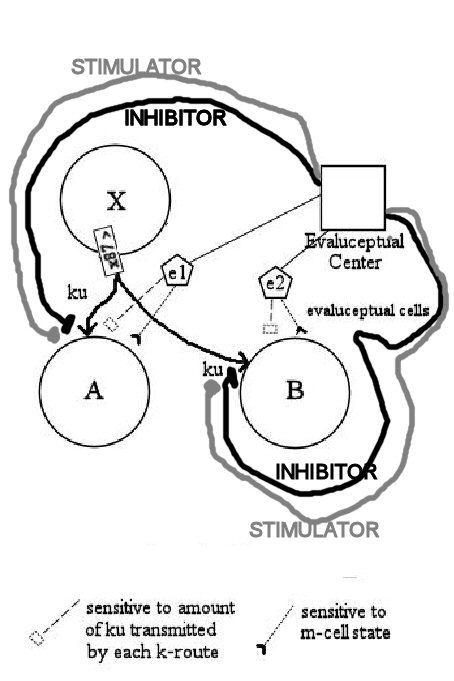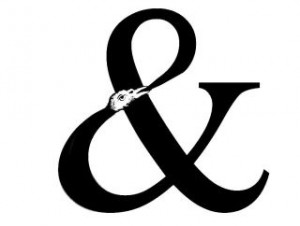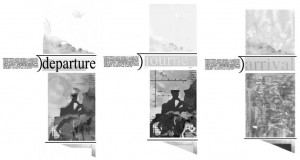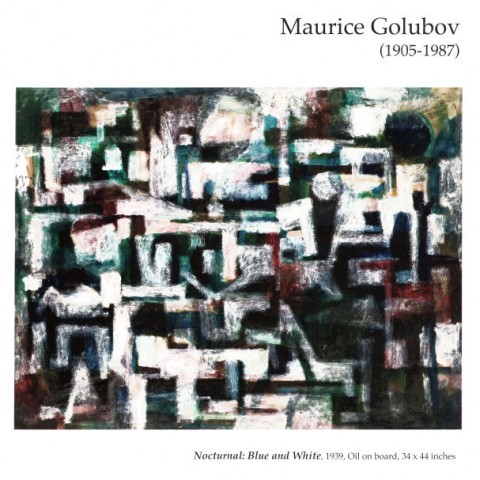The following is a very rough, very brief account of cerebral pain and pleasure. There are also pre-cerebral pain and pleasure. Although they have a small role to play in over-all aesthetic pleasure and pain, it is too small to be worth (probably confusing) discussion here. I plan to make my account part of my book concerning the taxonomy of poetry.
The Evaluceptual Awareness
The evaluceptual awareness is where a brain evaluates its experience. In my theory there are two evaluceptual responses possible (in the cerebrum, at any rate, which is nearly all this book is concerned with): knowlecular frustration and knowlecular resolution, which I will hereafter be referring to as, simply, frustration and resolution. The former results whenever a knowlecule receiving k-units (cerebral energy) fails to become immediately active as a memory.
Resolution, on the other hand, results from any knowlecule’s getting k-units to a knowlecule that becomes immediately active, even if its k-units weren’t responsible for its activation (as would be the case if it sent too few k-units to a knowlecule to activate it immediately but k-units from elsewhere, or perceptual stimulation, were enough to do that). An evaluception-cell is associated with every m-cell. It is sensitive to how many k-units any k-route transmitts to the m-cell it isassociated with during a given instacon, and whether or not the m-cell becomes immediately active.
If the m-cell does become active, the evaluceptual-cell causes the enhancement of each k-route that sent it k-units to in proportion to the number of k-unitseach route sent. If the m-cell does not become active, the evaluceptual-cell causes the inhibition of each k-route that sent it k-units in proportion to the number of k-units each route sent. That is, if resolution occurs at the site of one m-cell, the k-routes contributing to it are rewarded with enhancement; if frustration comes about there, the contributing k-routes are penalized with inhibition. An enhanced k-route will thereafter multiply whatever k-units it transmits to the degee that it is enhanced; the reverse is true for an inhibited k-route, which will divide any k-units given it to transmit. It’s quite simple, as shown below.

M-cell X, activated, transmits k-units of cerebral energy to m-cells A and B via route X87, which will diverge into two routes, X87A and X87B. The broken lines ending in little rectangles from the Evaluceptual Center read the amount of energy A and B receive and report the amount the the Center. Let’s say A then becomes active. The line from the Center to A ending in an inverted v will tell the Center that, whereupon the Center will use its Stimulator to enhance route X87A. That will mean that the next time X is activated, it will favor its X87B route.
If at the same time B fails to become active, the reverse will happen. X87B will be inhibited, and X, when next active, will reduce the amount of energy it transmits to B.
Meanwhile, all evaluceptual-cells active during a given instacon (smallest chronological unit of consciousness) will transmit the strength of the frustration or resolution at their m-cells to the Evaluceptual Center. The latter will give the instacon its evaluceptual rating, or final evaluceptual coloring. A surplus of frustration will cause a feeling of pain, a surplus of resolution pleasure. If a moment’s frustration and resolution are equal (or nearly so), then the moment will be evaluceptually neutral, and cause neither pain nor pleasure.
The way frustration and resolution work makes biological sense, for it means that events (or thoughts) that are unexpected, events (or thoughts) not forecast, will cause pain, and those that are expected will cause pleasure. The predicted should be pleasurable because one has dealt with it before and, apparently, found it to be safe–or, at any rate, survived it. The unpredicted, however, may be dangerous, so ought to seem painful. The neurophysiological results (according to my theory) of frustration and resolution build on this logic. They are, to put it simply, avoidance of anything that causes pain to the degree that it is painful (until it becomes familiar enough not to cause pain), wariness of anything that causes neither pain nor pleasure, and attraction to anything that causes pleasure to the degree that is does that.
This entry was posted on Thursday, September 30th, 2010 at 12:00 AM and is filed under Aesthetics, Awarenesses, Knowlecular Psychology. You can follow any responses to this entry through the RSS 2.0 feed. You can leave a response, or trackback from your own site.




numwords
Good one, mIEKAL.